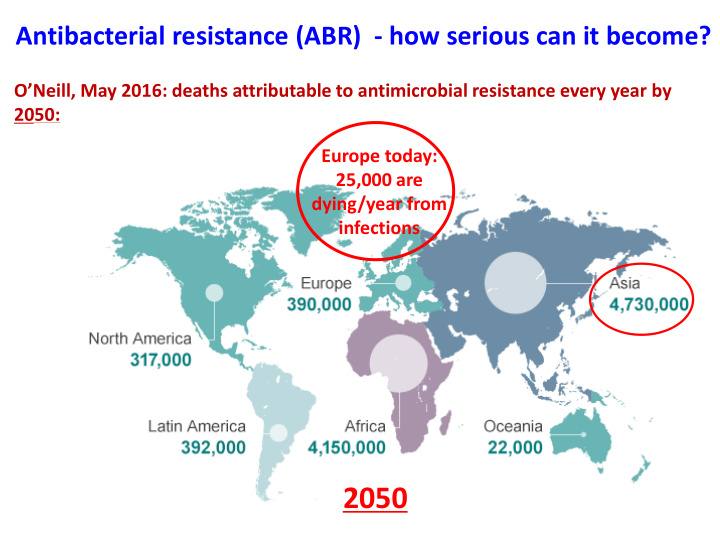



Antibacterial resistance (ABR) - how serious can it become? O’Neill, May 2016: deaths attributable to antimicrobial resistance every year by 2050: Europe today: 25,000 are dying/year from infections 2050
ABR - how did it start? 1944: - Penicillin G on the market - Time Magazine, May 15, 1944:
ABR – the historical picture “INDUSTRIAL SILENCE” ABOVE the line: time when new antibiotics Minimal Drug were launched: discovery and development marketed Last 30 years: only three new drug classes resistance found MRSA UNDER the line: when resistant bacteria to that drug was found (color coded)
ABR – what caused it? Antibiotic We did! Overuse Regulatory Inapropriate Lack of prescribing control/ barriers ABR Few new Extensive antibiotics/ agricultural reluctant use: profit! industry
Regulatory regional lack of control!
The ZinChel project: results Testing Clinical Isolates of Resistant Bacteria (Ø. Samuelsen, UNN) Meropenem + Zinchel compound Meropenem: last ZinChel ZN148 ZN148 resort antibiotic + Still happy Still happy Not resistant and resistant! and resistant! and dead!
What about toxicity in eucaryotic cells (e.g. human cells) and live animals? Studies in live animals: necessary for - ZinChel are zinc-binders development of new medicines - Red blood cells (RBC) contain iron - After very large and repeated doses - ZinChel could destroy RBC to healthy mice: - No animals died, no clinical signs. I still feel fine! Tromsø, February 2016: No destruction of red blood cells!
ABR - the only way forward – to join forces!! National and Global international Health Apocalypse now! political Authorities actions! ABR • • Restricting AB misuse Restricting AB misuse • • Funding research Funding research • • Funding innovation Funding innovation Pharmaceutical Industry Development competence!
Summary • 3 new classes of antibiotics in 30 years! • Not working against the worst bacteria. • People are dying right now witout cure. • ZinChel: new discovery - dramatically reduces resistance. • Making old antibiotics great again ? • Key study finished: in vivo tox: compounds practically nontoxic! • Key studies under planning: • Can Zinchel develop resistance over time? • Can infected animals be cured? • If positive after this, development towards clinic will start!
People: Professor Pål Rongved MSc student Espen Frøvold Professor Tor Gjøen Msc Ørjan Apeland Dr O. Alexander H. Åstrand Msc student Roya Popal Dr Geir Kildahl-Andersen Associate Professor Ørjan Samuelsen Dr Christian Schnaars Dr Silje Lauksund Dr Peter Molesworth Christopher Frölich Dr Bora Sieng Associate Professor Lars Petter Jordheim PhD student Elvar Örn Viktorsson Associate Professor Annette Bayer PhD student Anthony Prandina Dr Hanna-Kirsti Leiros PhD student Adriana M. S. Andresen Places: Funding: Center for Integrative Microbial Evolution, UiO
Thank you for your attention…
Recommend
More recommend